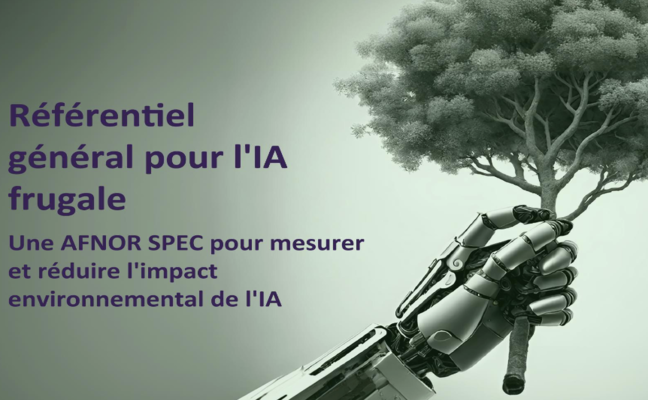Digital ecological footprint : standardization of frugal AI
According to the ARCEP & ADEME study of 2023, 2.5% is the weight of digital technology in France’s carbon footprint. The ecological footprint of the algorithms necessary for the operation of AI systems is proven and significant given that they are major consumers of energy, resources (water, metals and minerals), infrastructure (networks, data centers and terminals).
Ecolab has directly addressed this issue and, in collaboration with AFNOR, has written a reference document (named AFNOR Spec 2314). This allows digital players to assess the environmental impact of their artificial intelligence projects, and to communicate on the frugal nature of these projects.
The objective is above all to equip French stakeholders in the development and implementation of frugal AI. To do this, more than a hundred people have been involved in this work. They come from businesses and industries, non-governmental organizations, academia and research, government, consumer associations, SMEs and the environmental sector.
General frugal AI guidelines
You are a producer or service provider and would like to measure and reduce the environmental impact of your services and thus communicate about the frugality of your service? You are a client of AI and civil society and would like to assess the declarations of suppliers and producers ?
Ecolab provides you the General frugal AI guidelines and their operational summary so that you can quickly grasp the key information of the AI system assessment methodology.

Give us feedback !
Do you use the guidelines as part of your missions? Share your experience by sending us an email :
ia.ecolab.sri-cgdd@developpement-durable.gouv.fr
Standardization on a European scale
Efforts to achieve a common methodology on the environmental impact of AI are now also being carried out within the European Committee for Standardization, more precisely within its “Joint Technical Committee 21 (JTC 21). The Preliminary Work Item (PWI) on “Guidelines and metrics for the Environmental impact of artificial intelligence” was validated on June 10 and pursues several goals : to define guidelines for methods for measuring the environmental impact of AI and the dissemination of good practices ; to promote easy-to-use tools for understanding and taking action around the development and use of AI systems ; to fill the gap in normative literature in terms of shared calculation methods.
This paper will help reduce costs and achieve economies of scale, by integrating better risk management in a context of resource scarcity and climate emergency. SMEs will be able to build on this work to differentiate themselves in the market by developing frugal AI models.
Compute the environmental impact of your artificial intelligence solutions with Green Algorithms
AI project leaders can measure the environmental impact of the digital products and services developed. They can notably rely on the Green Algorithms (GT) tool. To go further, project leaders can consult the GDS EcoInfo framework document on measuring the life cycle impact of an AI project.
General framework for Frugal AI in the French media
Press
- L’Etat sort son premier référentiel sur l’IA frugale pour mettre tout le monde d’accord, Acteurs publics, 2 juil. 2024 : https://acteurspublics.fr/articles/letat-sort-son-premier-referentiel-sur-l-ia-frugale-pour-mettre-tout-le-monde-daccord
- Un référentiel pour une “intelligence artificielle frugale”, Environnement magazine, 2 juil. 2024 : https://www.environnement-magazine.fr/cleantech/article/2024/07/02/149452/referentiel-pour-une-intelligence-artificielle-frugale
- Le référentiel général IA frugale est sur les rails, Alliancy, 10 juil. 2024 : https://www.alliancy.fr/referentiel-general-ia-frugale-rails
- Un référentiel en faveur de l’IA frugale, Construction 21, 3 juil. 2024 : https://www.construction21.org/france/articles/h/un-referentiel-en-faveur-de-l-ia-frugale.html
- Référentiel général pour l’IA frugale, Centre Inffo, 16 juil. 2024 : https://www.centre-inffo.fr/site-centre-inffo/referentiel-general-pour-lia-frugale
- Stratégie nationale pour l’intelligence artificielle : un référentiel pour mesurer et réduire l’impact environnemental de l’IA, Média Connect, 8 juil. 2024 : https://mediaconnect.com/strategie-nationale-pour-lintelligence-artificielle-un-referentiel-pour-mesurer-et-reduire-limpact-environnemental-de-lia
- Un référentiel pour réduire l’impact environnemental de l’intelligence artificielle, Archimag, 12 juil. 2024 : https://www.archimag.com/numerique-responsable/2024/07/12/referentiel-afnor-reduire-impact-environnemental-intelligence (« l’AFNOR publie un référentiel »)
- Tout savoir sur le nouveau référentiel général pour l’IA frugale avec Juliette Fropier !, Newsletter Entrepreneurs d’avenir, 16 juil. 2024 : https://www.entrepreneursdavenir.com/actualites/tout-savoir-sur-le-nouveau-referentiel-general-pour-lia-frugale-avec-juliette-fropier/
- L’insoutenable coût écologique du boom de l’IA, Reporterre, 4 juil. 2024 : https://reporterre.net/L-insoutenable-cout-ecologique-du-boom-de-l-IA
